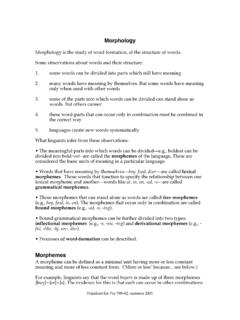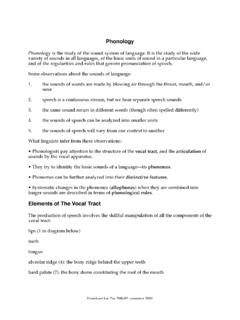Transcription of Two-Word Utterances - Duquesne University
1 Handout for Psy 598-02, summer 2001 Two-Word UtterancesWhen does language begin? In the middle 1960s, under the influence of Chomsky svision of linguistics, the first child language researchers assumed that language beginswhen words (or morphemes) are combined. (The reading by Halliday has someillustrative citations concerning this narrow focus on structure. )So our story begins with what is colloquially known as the Two-Word stage. The transition to 2-word Utterances has been called perhaps, the single most disputedissue in the study of language development (Bloom, 1998).A few descriptive points:Typically children start to combine words when they are between 18 and 24 months ofage.
2 Around 30 months their Utterances become more complex, as they add additionalwords and also affixes and other grammatical first word-combinations show a number of characteristics. First, they aresystematically simpler than adult speech. For instance, function words are generally that the omission of inflections, such as -s, -ing, -ed, shows that the child is beingsystematic rather than copying. If they were simply imitating what they heard, there isno particular reason why these grammatical elements would be omitted. Conjunctions(and), articles (the, a), and prepositions (with) are omitted too. But is this because theyrequire extra processing, which the child is not yet capable of?
3 Or do they as yet conveynothing to the child can she find no use for them?Second, as Utterances become more complex and inflections are added, we find thefamous over-regularization which again shows, of course, that children aresystematic, not simply copying what they s InfluenceResearch on child language was behavioristic in the years that preceded Chomsky scritique of Skinner, and his publication of Syntactic Structures: though there had been precedents for setting problems in the study ofchild language acquisition at a more abstract, cognitive level by continentalscholars--most notably, Roman Jacobson ( , 1941/1968)--much of theresearch on child language acquisition at midcentury was influenced to agreater or lesser degree by the highly concrete, behaviorist orientation of Skinner and others.
4 Two events were of major important in the changefrom behaviorist to cognitive thinking in research on child language. Thefirst was Chomsky s classic review (1959) of Verbal Behavior, Skinner smajor book-length work on the learning and use of language; the secondPackerTwo-Word Utterances 2was the detailed longitudinal study of the acquisition of English by threeyoung children conducted over a 17-month period by Roger Brown andothers in the early 1960s (Brown, 1973). Ritchie, W. C., & Bhatia, T. K. (1999). Child language acquisition:Introduction, foundations, and overview. In W. C. Ritchie & T. K. Bhatia (Eds.),Handbook of child language acquisition, (pp.)
5 3-30). San Diego: Academic Press,p. 3-4 note 2. A child who has learned a language has developed an internal representation of asystem of rules (Chomsky, 1965, p. 25).The psychologist s task, it follows, is to determine what the child s rules are. Thelinguist constructing a grammar for a language is in effect proposing a hypothesisconcerning the internalized system (Chomsky, 1968, p. 23).Up to the 1950s, people simply counted characteristics such as sentence complexity,proportion of grammatical Utterances , Chomsky, the search was on for child grammars, assumed to be Brown s ResearchIn 1956 Roger Brown heard Chomsky for the first time, speaking at Yale.
6 In 1962 hebegan a five-year research project on children s language at Harvard University . Thehistorical significance of Brown s laboratory at Harvard can hardly be exaggerated. Thenames of students and colleagues who worked with Brown pop up all the time, to thisday, in psycholinguistic research: the list includes Jean Berko Gleason, Ursula Bellugi,David McNeill, Dan Slobin, Courtney Cazden, Richard Cromer, Jill de Villiers, MichaelMaratsos, Melissa Bowerman, Eleanor Rosche, Sue Ervin (now Ervin-Tripp), set out to write grammars for each of the stages of language development, bylooking at the distribution of forms and construction patterns in spontaneous speech.
7 Inmost cases the data allow for more than one grammatical description. The descriptionto be preferred, of course, is the one that corresponds to the way the speaker s linguisticknowledge is structured, the one that determines the kinds of novel utterance he canproduce or understand, how he constructs their meanings, and what his intuitions areabout grammatical well-formedness (Bowerman, 1988, p. 28) Every child processes the speech to which he is exposed so as to induce from it a latentstructure. This latent rule structure is so general that a child can spin out itsimplications all his life The discovery of latent structure is the greatest of theprocesses involved in language acquisition, and the most difficult to understand (Brown & Bellugi, 1964, p.)
8 314)Brown collected samples of spontaneous speech from three children, given thepseudonyms Adam, Eve, and Sarah. The corpus of collected data can be found in thePackerTwo-Word Utterances 3 CHILDES archive. Eve was visited from age 18m to 26m, Adam from 27m to 42m,Sarah from 27m to Slobin described the project: We paid close attention to the auxiliary system and to word-order patterns,because these had played a central role in Syntactic Structures. We kept track ofsentence types affirmative, negative, and questions in which use of auxiliariesand word order would vary. Linguistic growth was assessed in terms of things tobe added to childish sentences to make them adult-like: the additions of omittedfunctors (inflections, prepositions, articles, and the like) and transformationaloperations.
9 We did not categorize Utterances in terms of communicativeintent that is, in terms of semantics or speech acts or extended discourseskills and so we did not look for growth in terms of additions or enrichment ofsuch abilities. Our central concern was with syntax and morphology, with somelater interest in prosody. We worried about such questions as whether childgrammar was finite state or transformational, and whether syntactic kernels were the first sentence forms to appear in child speech (Slobin, 1988, p. 11).Mean Length of UtteranceThis simple measure of syntactic complexity was introduced by Roger 7. Rules for calculating mean length of utterance and upper bound (Brown, 1973, p.)
10 54)1. Start with the second page of the transcription unless that page involves a recitation of some this latter case start with the first recitation-free stretch. Count the first100 Utterances satisfying thefollowing Only fully transcribed Utterances are used; none with blanks. Portions of Utterances , entered inparentheses to indicate doubtful transcription, are Include all exact utterance repetitions (marked with a plus sign in records). Stuttering is marked asrepeated efforts at a single word; count the word once in the most complete form produced. In the fewcases where a word is produced for emphasis or the like (no, no, no) count each Do not count such fillers as mm or oh, but do count no, yeah, and All compound words (two or more free morphemes), proper names, and ritualized reduplicationscount as single words .


